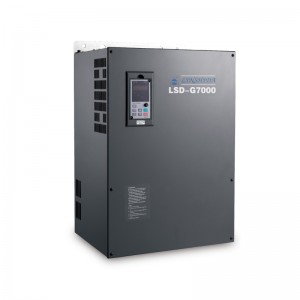High-performance General Vector Inverter LSD-G7000 (VFD) will have some problems in the working process, such as vibration and noise, which are common problems of VFD in work. So, what causes vibration and noise in VFDs? What are the solutions to these problems? The following is a detailed introduction to the causes and treatment methods of VFD vibration and noise.
The reason for the vibration and noise is that when the High-performance General Vector Inverter LSD-G7000 is working, the magnetic field generated by the high-order harmonics in the output waveform generates electromagnetic actuating force on many mechanical parts. The frequency of the actuating force is always close to or coincides with the natural frequency of some mechanical parts, resulting in resonance.
The high-order harmonics that have a greater impact on vibration are mainly low-order harmonic components, which have a greater impact in the PAM (Pulse Amplitude Modulation) mode and the square wave PWM mode. However, when the sine wave PWM method is used, the low-order harmonic components are small, and the influence becomes small. When a motor is driven by a VFD, the output voltage and current contain high-order harmonic components, and the high-order harmonic magnetic flux of the air gap increases, so the noise increases. Electromagnetic Instrument World Network gives the following features:
Since the low-order harmonic components resonate with the natural mechanical frequency of the rotor, the noise near the natural frequency of the rotor increases. The higher harmonic components in the output resonate with the bearing frame of the iron core housing, etc. And the noise around the respective natural frequencies of these components increases. The noise generated by the VFD drive motor, especially the harsh noise, is related to the switching frequency of the PWM control, especially in the low frequency region. When a VFD is used for speed regulation, noise and vibration are generated, which are caused by higher harmonic components in the VFD output waveform. With the change of the working frequency, the fundamental wave component and the high-order harmonic component change in a large range, and may resonate with various parts of the motor.
Vibration and noise treatment In order to reduce or eliminate vibration, an AC reactor can be connected to the VFD output to absorb the higher harmonic current components in the VFD output current.
When using PAM mode or square wave PWM mode VFD, sine wave PWM mode VFD can be used to reduce ripple torque. In order to prevent vibration of the mechanical system consisting of the motor and the load, the entire system must not resonate with the electromagnetic force generated by the motor. The following measures are generally used to suppress and reduce noise: Connect an AC reactor on the output side of the VFD. If there is an electromagnetic torque margin, U/f can be set smaller. If a special motor is used, the resonance with the natural frequency of the shaft system (including the load) should be checked if the amount of noise at lower frequencies is severe.
Post time: Jun-24-2022

